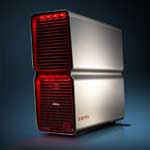Dell XPS 700 vs. DIY PC


This got me wondering. How much would it cost me to build a system that’s functionally similar to the XPS 700? Or, putting the question another way, how much extra is Dell charging the consumer for the XPS 700?
I decided to find out.
Before I go any further, a few caveats.
- Dell is somewhat vague about the specification of the XPS 700 on their website (odd for such an expensive PC – I would have expected a much more detailed spec). Because of this I’ve had to make a few guesses as to which parts to choose.
- Everything I list for my PC is straight out of the Newegg online catalog. I’ve done this for convenience - I have no affiliation with Newegg and encourage you to look for good deals from your own favorite vendor.
OK, first off I went to the Dell Online Store and put together a sample system. Here’s a summary of the Dell spec:
- Pentium 965 Extreme Edition Dual Core (3.73GHz, 4MB cache)
- 4GB dual channel DDR2 667MHz
- Windows XP Professional
- 250GB SATA 3Gb/s hard drive (7,200RPM)
- Dual optical drives:
- 16x DVD-ROM drive
- 16x DVD+/-RW dual layer - NVIDIA Gen 7 series graphics, 2 dual-GPU cards, Quad SLI-enabled (this is a very vague description by Dell)
- Sound Blaster X-Fi XtremeMusic 5.1 sound card
- 10W speakers
- 20 inch flat panel
That’s the system. Total price of that system from Dell came to $4,841.
OK, now what could I come up with that I can build for myself? Here are the parts I chose (all prices rounded up nearest $):
- Intel Pentium Extreme Edition 965 1066MHz FSB LGA 775 Processor (link) $1,043
- Microsoft Windows XP Professional With SP2 OEM (link) $153
- ASUS P5N32-SLI Deluxe Socket T (LGA 775) NVIDIA nForce4 SLI ATX Intel Motherboard (link) $199
- OCZ Gold Series 4 x 1GB 240-Pin DDR2 SDRAM Unbuffered DDR2 667 (link) $420 [Updated: June 4, 2006 @ 11:46 pm]
- NVIDIA Geforce 7900GTX 512MB GDDR3 PCI Express x16 (link) $574
- Western Digital Caviar SE WD2500JS 250GB 7200 RPM SATA 3.0Gb/s (link) $85
- SONY Black IDE DVD-ROM (link) $20
- SONY 16X DVD±R DVD Burner (link) $37
- Acer F-20 Black-Red 20" 8ms Widescreen LCD Monitor (link) $450
- Creative Sound Blaster X-Fi Elite 7.1 Channels PCI (link) $385
- Athena Power AP-P4ATX85FE ATX12V & EPS12V 850W Power Supply (link) $290
Total price for this system comes to roughly $3,656. That’s a shade under $1,200 less than the Dell system. This system does still need a case and of course you would need the know-how to assemble it, but the upside is that you end up with a custom system. By choosing the parts yourself you can also take advantage of the deals that you find, saving you even more money.
On the subject of the case, there’s another reason I don’t like the XPS; while the XPS 700 case might look good, it’s unproven when it comes to dealing with the kind of heat a gaming PC can generate. If I were building a system with the parts listed above I’d put them into a Thermaltake case, maybe the Armor full-size chassis, which has excellent cooling abilities and even has space for a liquid-cooling system.
If I were serious about building this kind of gaming rig, there are a few changes that I’d make (such as ditching the Intel CPU and going for an AMD Athlon 64 X2 instead, as well as fitting a liquid cooling system), but the price would still come in at about $800 cheaper than the equivalent offering from Dell. You also get to choose everything that you put into your rig, and you have all the drivers and documentation – something I’ve found to be priceless over the years. I have to admit that the vague specification on Dell’s website bothers me. Getting to the point where I could hand over nearly $5,000 to Dell without knowing what motherboard and graphics card I’m getting feels … strange. I guess Dell is aiming the XPS range at people who want choices, but not too much information. While the XPS 700 case might look good, it’s unproven when it comes to dealing with the kind of heat a gaming PC can generate
All that said, I’m aware that not everyone is up to building their own PC. People don’t like the uncertainty, the choices, or they fear ending up with a box full of expensive parts that won’t fit together. But I’m also aware that many people in the market for a high-power gaming rig do indeed possess the skills needed to assemble their own systems. If you are such a person, then you could save a lot of money by going down the DIY route as well as ending up with the system that’s right for you.